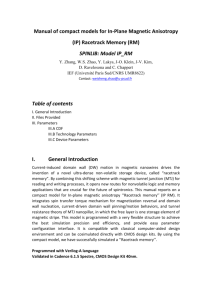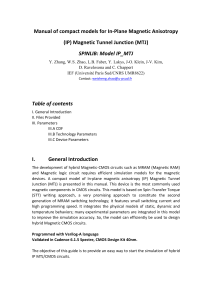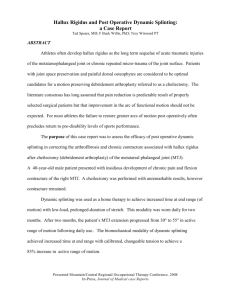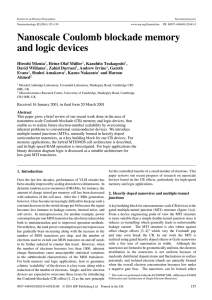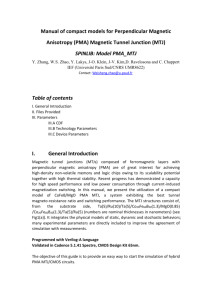Simulation of high-speed single-electron memory
advertisement
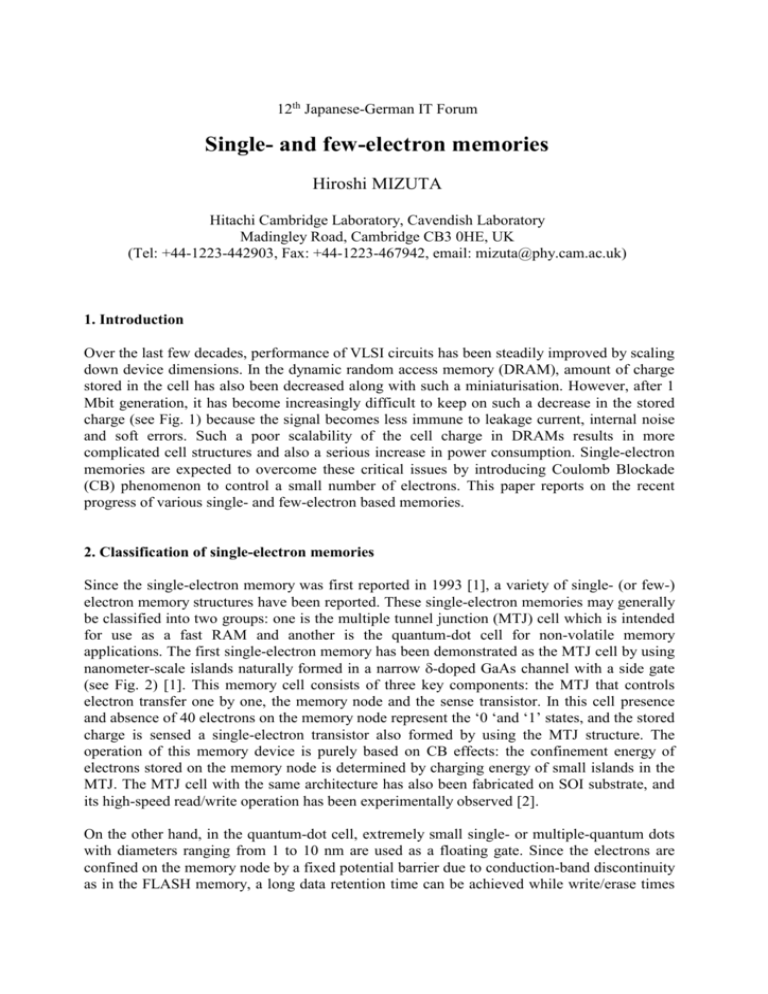
12th Japanese-German IT Forum Single- and few-electron memories Hiroshi MIZUTA Hitachi Cambridge Laboratory, Cavendish Laboratory Madingley Road, Cambridge CB3 0HE, UK (Tel: +44-1223-442903, Fax: +44-1223-467942, email: mizuta@phy.cam.ac.uk) 1. Introduction Over the last few decades, performance of VLSI circuits has been steadily improved by scaling down device dimensions. In the dynamic random access memory (DRAM), amount of charge stored in the cell has also been decreased along with such a miniaturisation. However, after 1 Mbit generation, it has become increasingly difficult to keep on such a decrease in the stored charge (see Fig. 1) because the signal becomes less immune to leakage current, internal noise and soft errors. Such a poor scalability of the cell charge in DRAMs results in more complicated cell structures and also a serious increase in power consumption. Single-electron memories are expected to overcome these critical issues by introducing Coulomb Blockade (CB) phenomenon to control a small number of electrons. This paper reports on the recent progress of various single- and few-electron based memories. 2. Classification of single-electron memories Since the single-electron memory was first reported in 1993 [1], a variety of single- (or few-) electron memory structures have been reported. These single-electron memories may generally be classified into two groups: one is the multiple tunnel junction (MTJ) cell which is intended for use as a fast RAM and another is the quantum-dot cell for non-volatile memory applications. The first single-electron memory has been demonstrated as the MTJ cell by using nanometer-scale islands naturally formed in a narrow -doped GaAs channel with a side gate (see Fig. 2) [1]. This memory cell consists of three key components: the MTJ that controls electron transfer one by one, the memory node and the sense transistor. In this cell presence and absence of 40 electrons on the memory node represent the ‘0 ‘and ‘1’ states, and the stored charge is sensed a single-electron transistor also formed by using the MTJ structure. The operation of this memory device is purely based on CB effects: the confinement energy of electrons stored on the memory node is determined by charging energy of small islands in the MTJ. The MTJ cell with the same architecture has also been fabricated on SOI substrate, and its high-speed read/write operation has been experimentally observed [2]. On the other hand, in the quantum-dot cell, extremely small single- or multiple-quantum dots with diameters ranging from 1 to 10 nm are used as a floating gate. Since the electrons are confined on the memory node by a fixed potential barrier due to conduction-band discontinuity as in the FLASH memory, a long data retention time can be achieved while write/erase times are generally rather long. The first quantum-dot cell was fabricated by utilising polycrystalline silicon grains with a typical size of 3 nm naturally formed in a poly-silicon quantum wire [3]. In this structure a grain acts as a floating gate of the memory cell, and the charge stored in the grain is sensed as a change in conductance between the source and drain. A critical issue of a large spread of the threshold-voltage shift has been overcome by adopting a verify process [4], and room-temperature-operation of a prototype 128 Mb memory cell array has recently been demonstrated [5]. There have also been alternative approaches to achieve the quantum-dot cell: silicon or germanium nanocrystals formed in an oxide layer by ion implantation [6] and a single nanometer-scale dot formed by using a cutting edge technology [7] were successfully used as a memory node of the quantum-dot cell. 3. High-speed MTJ cell for fast RAM applications [8] The initial works on the MTJ cells introduced above have recently led to a new silicon-based L-SEM (Lateral Single Electron Memory) architecture suitable for use as a fast RAM [9][10]. In the L-SEM cell, an in-plane MTJ is integrated into the memory node on the split-gate MOSFET (see Fig. 3(a)). High-speed write operation of the L-SEM is achieved by the electrons tunnelling through the MTJ between the write word electrode and the memory node. The memory-cell array consists of one L-SEM device connected to the source and data lines and read and write word lines (Fig. 3(b)). Figure 4(a) shows the write cycle timing diagram used for the common source and data voltage, Vsy (=Vs=Vy), and write word line voltage, VWWL. To evaluate the write time of the L-SEM, transient memory node voltages were simulated by using a Monte Carlo singleelectron circuit simulator [11]. In Fig. 4(b), the time-dependence of the memory node voltage (black broken line) and the corresponding number of electrons stored on the memory node (red broken line) are shown: fast switching is achieved between high and low levels. The switching time limit was investigated by changing VWWL. As shown in Fig. 5 the switching occurs above a certain threshold voltage, and the switching time tTHL is decreased to less than 10 nsec with increasing VWWL, which is comparable to the conventional DRAMs. This is simply because a larger tunnelling current flows through the MTJ with increasing VWWL, and the switching time approaches the limit determined by CRt where C and Rt are the total memory node capacitance and MTJ tunnel resistance. Stored memory node voltage Vnode is sensed by a split-gate MOSFET (Fig. 3(a)). The two gates besides the central memory node act as switch transistors to connect the memory node to the data line. This sense transistor structure enables us to select a particular row of the memory array by applying read word voltage VRWL without disturbing the stored data. In the optimised structure, it has been shown that the change in the memory node voltage from -50 mV (“0” state) to 50 mV (“1” state) leads to an increase in Ids from 1nA/m to 1mA/m, which is large enough to be detected by standard sense amplifiers. A prototype L-SEM single cell has recently been fabricated (see Fig. 3(c)), and its operating principle has successfully been demonstrated [12]. In the presentation, the recent experimental results will be introduced, and, in addition, the crucial offset charge effects on the memory operation will be discussed. References [1] K. Nakazato, R. J. Blaikie, J. R. A. Cleaver and H. Ahmed, Electron. Lett. 29, 384, 1993. [2] N. J. Stone and H. Ahmed, Microelectronics Engineering 98, and also N. J. Stone, K. Nakazato and H. Ahmed, submitted to IEEE Electron Device Lett. [3] K. Yano, IEEE Trans. Electron Devices ED-41, 1628, 1994. [4] T. Ishii, K. Yano, T. Sano, T. Mine, F. Murai and K. Seki, IEDM Tech. Dig., 171, 1997. [5] K. Yano, [6] S. Tiwari, F. Rana, H. Hanafi, A. Harstein, E. F. Crabbe and K. Chan, Appl. Phys. Lett. 68, 1377, 1996. [7] L. Guo, E. Leobandung and S. Y. Chou, Appl. Phys. Lett. 70, 850, 1997. [8] This work was performed within the ESPRIT MEL-ARI project FASEM (Fabrication and Architecture of Single-Electron Memories). [9] H. Mizuta, D. Williams, K. Katayama, H. O. Muller, K. Nakazato and H. Ahmed, Proceedings of the Second International Workshop on Physics and Modeling of Devices Based on Low-dimensional Structures, pp.67-72, Aizu-Wakamatsu, March, 1998. [10] H. Mizuta, K. Katayama, D. Williams and H. O. Muller, Extended Abstract of 6th International Workshop on Computational Electronics, pp. , Osaka, October 1998. [11] [12] Z. Durrani, A. Irvine, H. Ahmed and K. Nakazato, Appl. Phys. Lett. 74, 1293, 1999.
